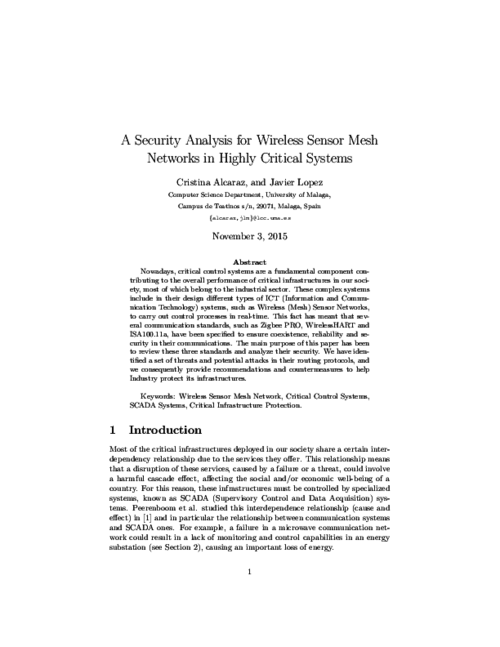 ] Title Type Year
] Title Type Year 8th International Conference on Critical Information Infrastructures Security, vol. 8328, Springer, pp. 120-132, 2013. DOI
Abstract
The problem of controllability of networks arises in a number of different domains, including in critical infrastructure systems where control must be maintained continuously. Recent work by Liu et al. has renewed interest in the seminal work by Lin on structural controllability, providing a graph-theoretical interpretation. This allows the identification of driver nodes capable of forcing the system into a desired state, which implies an obvious target for attackers wishing to disrupt the network control. Several methods for identifying driver nodes exist, but require undesirable computational complexity. In this paper, we therefore investigate the ability to regain or maintain controllability in the presence of adversaries able to remove vertices and implicit edges of the controllability graph. For this we rely on the POWER DOMINATING SET (PDS) formulation for identifying the control structure and study different attack strategies for multiple network models. As the construction of a PDS for a given graph is not unique, we further investigate different strategies for PDS construction, and provide a simulative evaluation.
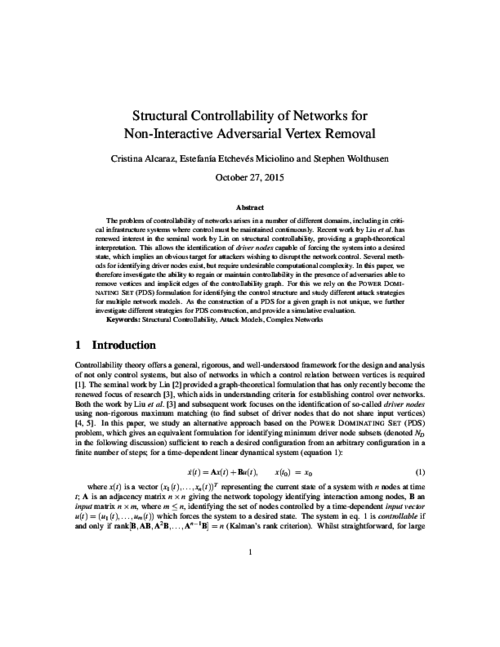
Critical Infrastructure Security and Resilience: Theories, Methods, Tools and Technologies, no. Advanced Sciences and Technologies for Security Applications book series (ASTSA), Springer International Publishing, pp. 201-217, 01/2019. DOI
Abstract
Increasingly, the society is witnessing how today’s industry is adapting the new technologies and communication protocols to offer more optimal and reliable services to end-users, with support for inter-domain communication belonging to diverse critical infrastructures. As a consequence of this technological revolution, interconnection mechanisms are required to offer transparency in the connections and protection in the different application domains, without this implying a significant degradation of the control requirements. Therefore, this book chapter presents a reference architecture for the new Industry 4.0 where the interconnection core is mainly concentrated in the Policy Decision Points (PDP), which can be deployed in high volume data processing and storage technologies such as cloud and fog servers. Each PDP authorizes actions in the field/plant according to a set of factors (entities, context and risks) computed through the existing access control measures, such as RBAC+ABAC+Risk-BAC (Role/Attribute/Risk-Based Access Control, respectively), to establish coordinated and constrained accesses in extreme situations. Part of these actions also includes proactive risk assessment measures to respond to anomalies or intrusive threats in time.
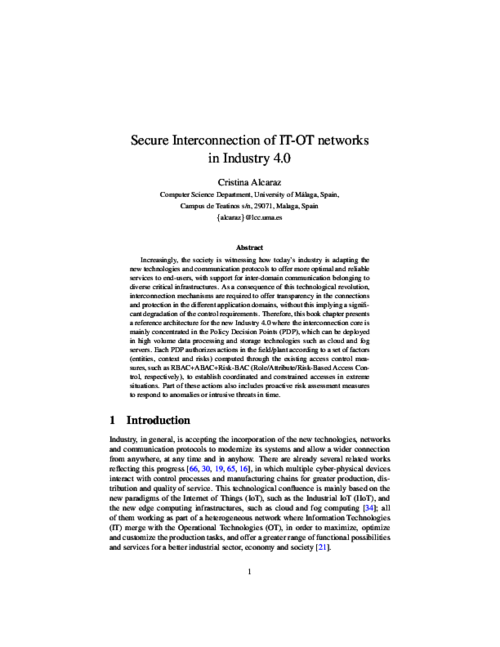
Concurrency and Computation Practice & Experience, vol. 23, no. 12, John Wiley & Sons, Inc., pp. 1414-1430, Aug 2011. DOI
Abstract
Energy distribution systems are becoming increasingly widespread in today’s society. One of the elements that is used to monitor and control these systems are the SCADA (Supervisory Control and Data Acquisition) systems. In particular, these control systems and their complexities, together with the emerging use of the Internet and wireless technologies, bring new challenges that must be carefully considered. Examples of such challenges are the particular bene¯ts of the integration of those new technologies, and also the e®ects they may have on the overall SCADA security. The main task of this paper is to provide a framework that shows how the integration of di®erent state-of-the-art technologies in an energy control system, such as Wireless Sensor Networks (WSNs), Mobile Ad-Hoc Networks (MANETs), and the Internet, can bring some interesting benefits such as status management and anomaly prevention, while maintaining the security of the whole system.
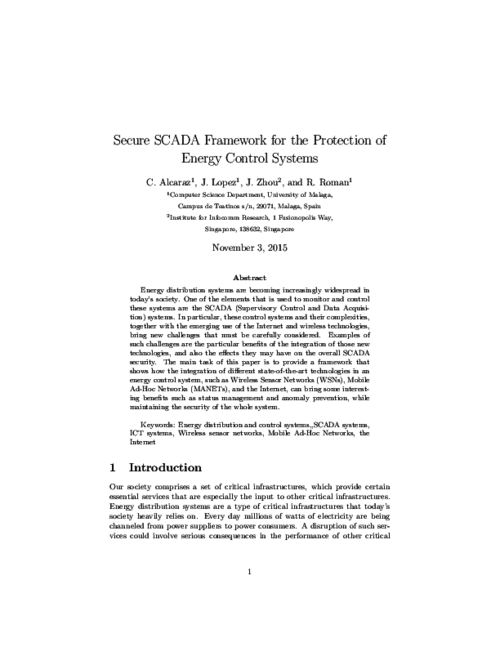
Security Solutions and Applied Cryptography in Smart Grid Communications, IGI Global, USA, IGI Global, pp. 137-158, 2017. DOI
Abstract
Transparency in control transactions under a secure network architecture is a key topic that must be discussed when aspects related to interconnection between heterogeneous cyber-physical systems (CPSs) arise. The interconnection of these systems can be addressed through an enforcement policy system responsible for managing access control according to the contextual conditions. However, this architecture is not always adequate to ensure a rapid interoperability in extreme crisis situations, and can require an interconnection strategy that permits the timely authorized access from anywhere at any time. To do this, a set of interconnection strategies through the Internet must be studied to explore the ability of control entities to connect to the remote CPSs and expedite their operations, taking into account the context conditions. This research constitutes the contribution of this chapter, where a set of control requirements and interoperability properties are identified to discern the most suitable interconnection strategies.
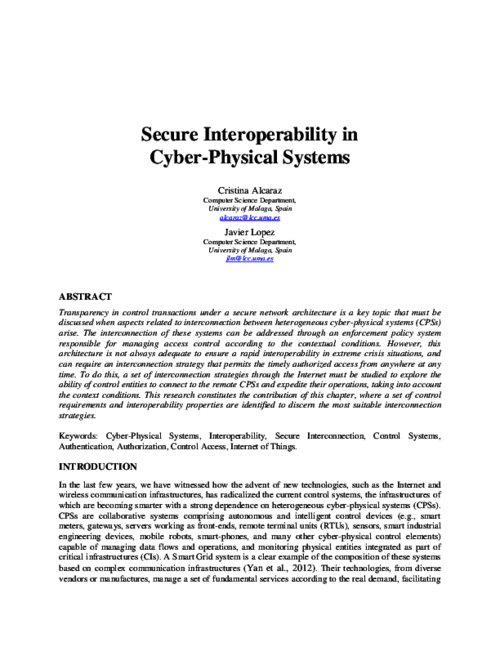
Computers & Security, vol. 31, no. 38, Elsevier, pp. 956–966, Nov 2012. DOI
Abstract
Key management in wireless sensor networks (WSN) is an active research topic. Due to the fact that a large number of key management schemes (KMS) have been proposed in the literature, it is not easy for a sensor network designer to know exactly which KMS best fits in a particular WSN application. In this article, we offer a comprehensive review on how the application requirements and the properties of various key management schemes influence each other. Based on this review, we show that the KMS plays a critical role in determining the security performance of a WSN network with given application requirements. We also develop a method that allows the network designers to select the most suitable KMS for a specific WSN network setting. In addition, the article also addresses the issues on the current state-of-the-art research on the KMS for homogeneous (i.e. non-hierarchical) networks to provide solutions for establishing link-layer keys in various WSN applications and scenarios.
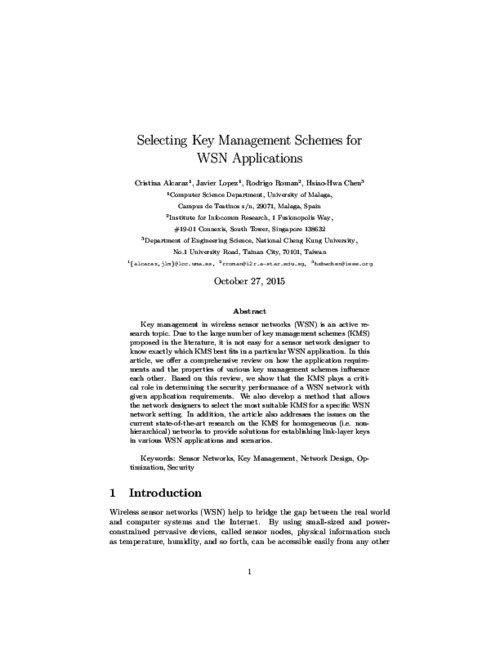
The 21st European Symposium on Research in Computer Security (ESORICS 2016), vol. 9879, Springer, pp. 471-489, 2016.
Abstract
Automatic restoration of control wireless networks based on dynamic cyber-physical systems has become a hot topic in recent years, since most of their elements tend to have serious vulnerabilities that may be exploited by attackers. In fact, any exploitation may rapidly extend to the entire control network due to its problem of non-locality, where control properties of a system and its structural controllability can disintegrate over time. Unfortunately, automated self-healing processes may become costly procedures in which the reliability of the strategies and the time-critical of any recovery of the control can become key factors to re-establish the control properties in due time. This operational need is precisely the aim of this paper, in which four reachability-based recovery strategies from a thereotical point of view are proposed so as to find the best option/s in terms of optimization, robustness and complexity. To do this, new definitions related to structural controllability in relation to the type of distribution of the network and its control load capacity are given in this paper, resulting in an interesting practical study.
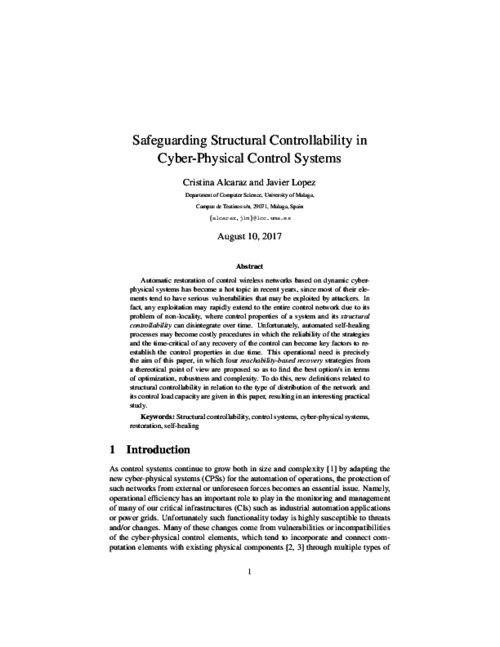
Critical Infrastructure Protection: Information Infrastructure Models, Analysis, and Defense, J. Lopez, S.. Wolthunsen, and R. Setola Eds., Advances in Critical Infrastructure Protection: Information Infrastructure Models, Analysis, and Defense. LNCS 7130. 7130, Springer-Verlag, pp. 120-149, September 2012.
Abstract
SCADA Systems can be seen as a fundamental component in Critical Infrastructures, having an impact in the overall performance of other Critical Infrastructures interconnected. Currently, these systems include in their network designs different types of Information and Communication Technology systems (such as the Internet and wireless technologies), not only to modernize operational processes but also to ensure automation and real-time control. Nonetheless, the use of these new technologies will bring new security challenges, which will have a significant impact on both the business process and home users. Therefore, the main purpose of this Chapter is to address these issues and to analyze the interdependencies of Process Control Systems with ICT systems, to discuss some security aspects and to offer some possible solutions and recommendations.
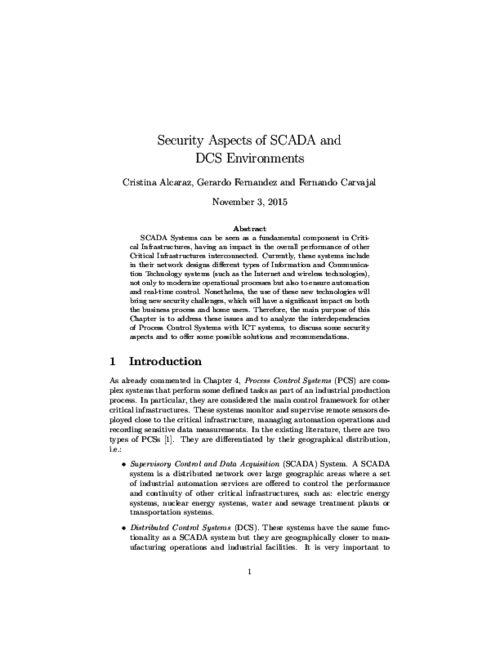
Encyclopedia of Cryptography, Security and Privacy, Springer Berlin Heidelberg, pp. 1--3, 08/2021. DOI
Novatica, New Trends in Network Management, vol. 9, no. 6, Cepis UPGRADE, pp. 22-28, December, 2008.
Abstract
When a Supervisory Control and Data Acquisition (SCADA) system monitors and manages other complex infrastructures through the use of distributed technologies, it becomes a critical infrastructure by itself: A failure or disruption in any of its components could implicate a serious impact on the performance of the other infrastructures. The connection with other systems makes a SCADA system more vulnerable against attacks, generating new security problems. As a result, it is essential to perform diverse security analysis frequently in order to keep an updated knowledge and to provide recommendations and/or solutions to mitigate or avoid anomalous events. This will facilitate the existence of a suitable, reliable, and available control network.
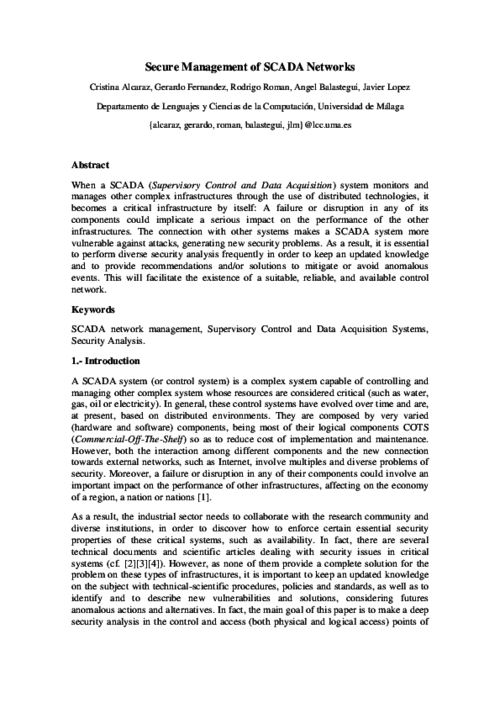
Ad Hoc Networks, vol. 11, Elsevier, pp. 1091–1104, 2013. DOI
Abstract
The main objective of remote substations is to provide the central system with sensitive information from critical infrastructures, such as generation, distribution or transmission power systems. Wireless sensor networks have been recently applied in this particular context due to their attractive services and inherent benefits, such as simplicity, reliability and cost savings. However, as the number of control and data acquisition systems that use the Internet infrastructure to connect to substations increases, it is necessary to consider what connectivity model the sensor infrastructure should follow: either completely isolated from the Internet or integrated with it as part of the Internet of Things paradigm. This paper therefore addresses this question by providing a thorough analysis of both security requirements and infrastructural requirements corresponding to all those TCP/IP integration strategies that can be applicable to networks with constrained computational resources.
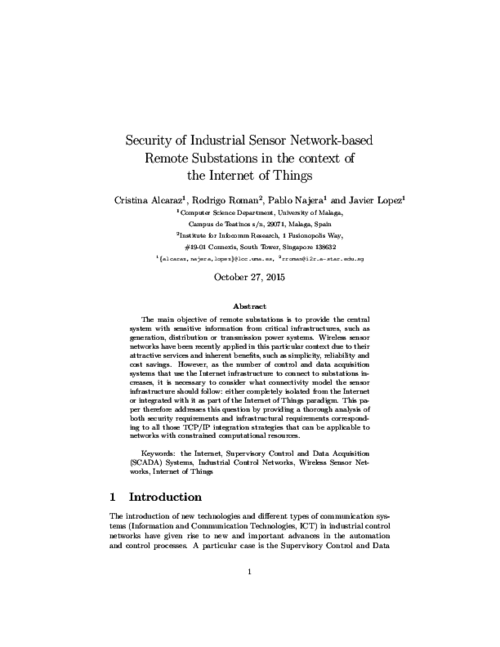
|
"Security and Privacy Trends in the Industrial Internet of Things", Advanced Sciences and Technologies for Security Applications, Springer, 2019. 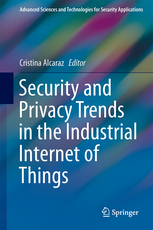 |  |
IEEE Transactions on Systems, Man, and Cybernetics, Part C: Applications and Reviews, vol. 40, no. 4, IEEE, pp. 419-428, July, 2010. DOI
Abstract
Nowadays, critical control systems are a fundamental component contributing to the overall performance of critical infrastructures in our society, most of which belong to the industrial sector. These complex systems include in their design different types of information and communication technology systems, such as wireless (mesh) sensor networks, to carry out control processes in real time. This fact has meant that several communication standards, such as Zigbee PRO, WirelessHART, and ISA100.11a, have been specified to ensure coexistence, reliability, and security in their communications. The main purpose of this paper has been to review these three standards and analyze their security. We have identified a set of threats and potential attacks in their routing protocols, and we consequently provide recommendations and countermeasures to help Industry protect its infrastructures.
